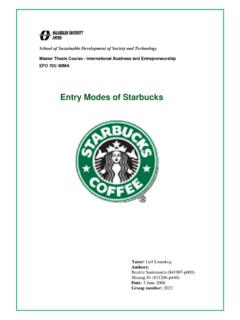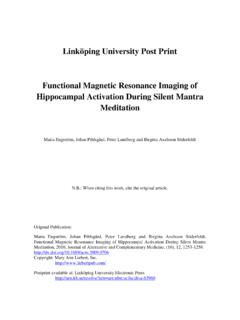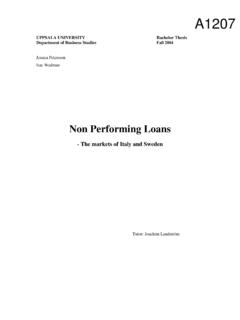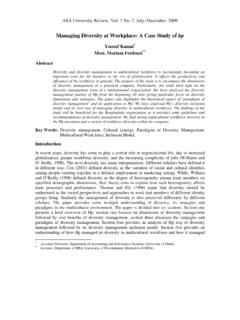Transcription of Managing Cultural Diversity at Workplace - DiVA portal
1 Managing Cultural Diversity at Workplace How is Cultural Diversity management perceived by employees at JIBS? Are the policies and practices same in terms of how they are being delivered? BACHELOR THESIS WITHIN: Business Administration NUMBER OF CREDITS: 15 ECTS PROGRAMME OF STUDY: Marketing Management AUTHOR: Rashidat Abidemi Anjorin, Avni Jansari TUTOR: Imran Nazir J NK PING May 2018 i Bachelor Thesis in Business Administration Title: Managing Cultural Diversity at Workplace Authors: Rashidat Abidemi Anjorin, Avni Jansari Tutor: Imran Nazir Date: 2018-05-21 Key terms: Cultural Diversity Management, Diversity at Workplace , Employee perception, Human Resource Management Abstract: Background.
2 Cultural Diversity within a Workplace is increasingly becoming important as more organisations are embracing it within the global workforce. Some of its effect have been linked to performance outcomes according to past reviews and as a result, there are more suggestions on the need to study how various organisations manage their Cultural Diversity . Universities as an organisation has also blended in the internationalisation practice through human resources and diverse employees to form a part of the economic globalisation. Purpose: The purpose if this paper is to examine how Cultural Diversity is managed in a Swedish university, J nk ping International Business School (JIBS).
3 Also, further investigation is on the employee s perception of how the practices and policies of Cultural Diversity is being delivered by the management at the university. Method: An exploratory research is conducted for this paper and the empirical findings is gathered through a qualitative research. The primary research is retrieved by semi-constructed interviews. The human resource department and teachers from different backgrounds and countries were interviewed to find out how the teachers perception of Cultural Diversity management at their Workplace based on how the practices and policies were delivered to them.
4 Findings: Based on the interviews it was found that the Cultural Diversity management as a topic is well understood by both the management and the employees. However, the study revealed that the employees do not perceive it in the same manner it was being delivered to them by the management. The issues and practices connected to Managing Cultural Diversity is not entirely provided by the management within the work environment. It essential that the management provide for more effectively communicated structure ii Acknowledgements We would like to thank the staffs at J nk ping International Business School and the HR specialist for their support towards making this thesis possible.
5 We would also like to thank our tutor Imran Nazir, for the support and insights given during the course. _____ _____ Rashidat Abidemi Anjorin Avni Jansari iii Table of Contents 1. Introduction .. 1 Background .. 1 Problem Formulations .. 2 Purpose .. 3 Delimitations .. 3 Definitions .. 4 Research Questions .. 4 2. Theoretical Background .. 5 Cultural Diversity Management at Workplace .. 5 Different Dimensions of Diversity .. 6 Benefits & challenges of Cultural Diversity Management at Workplace .. 6 Benefits of a Diverse 7 challenges for Cultural Diversity .. 8 How to Manage Cultural Diversity Differences.
6 9 The Relationship between HRM and Cultural Diversity Management .. 10 Human Recourse Management Practices .. 10 The Role of HRM in Cultural Diversity Management .. 12 Employee Perception Towards HR Practices .. 13 3. Methodology & Method .. 14 Methodology .. 15 Research Philosophy .. 15 Research Approach .. 15 Research Strategy .. 16 Case Study .. 16 Method .. 17 Data Collection .. 17 Primary Research .. 17 Criticism of the Chosen Method .. 18 Sample .. 18 Interview Design .. 18 Secondary Data .. 20 Data Analysis .. 20 Trustworthiness of Sources .. 21 Ethical Issues with Interviews .. 21 4. Empirical Findings & Analysis.
7 22 J nk ping International Business School .. 22 JIBS Organisational Structure .. 22 JIBS Policies, Practices & Strategies .. 24 Associate Dean of Faculty on Diversity Management .. 25 HR Specialist for JIBS .. 28 Selected Teachers at JIBS .. 31 Diversity Management at JIBS .. 32 iv JIBS Employee s Perception of Cultural Diversity .. 37 Support from JIBS and HRM .. 40 5. Conclusion .. 42 6. Discussion .. 43 Managerial Implications .. 43 Limitations .. 44 Future Research .. 45 References .. 45 50 1 1. Introduction _____ The purpose of this chapter is to introduce the reader to the study of Cultural Diversity Management at a Workplace .
8 The chapter will begin with presenting the background, and move on to the problem formulation and purpose of the study. Background With an increasing globalisation, people from diverse cultures, beliefs and backgrounds are required to interact more nowadays (Mazur, 2010). For years, an effective Diversity management has been utilised as a support and as a defence against discrimination (Shen, J, Chanda, D'Netto, and Monga, 2009). It became interesting to study Diversity at a Workplace , as the authors of this paper have noticed the growth of Diversity over the years. Also, attending an international business school which consist of diverse community becomes another interesting factor to see how Diversity is being managed.
9 In recent years, Diversity has become a significant part for the management. In addition, due to differences increasing in the population, Diversity is expected to become even more significant in the future. People are now a part of a worldwide economy that involves competition from all around the world and therefore Diversity is needed in organisations. Diversity in organisations is required to accept and adapt easily to change, and to increase creativeness (Shen et al., 2009). Furthermore, Shen et al, (2009) adds that Diversity issues are becoming more important and a relevant issue, and especially for the future, since the differences in the population is increasing in many countries.
10 Valuing and as well as Managing Diversity is a key element for an effective people management, which in turn can improve Workplace productivity (Mazur 2010). Internationalisation of business, growing workforce flexibility, world market development and increasing the awareness of diverse individuals, results in how Diversity management can take advantage of the increasing multiculturalism. In this regard, multiculturalism is a process where different culture or groups have same rights and opportunities and no one is considered unimportant. By having an equality in a workforce, leads to an organisation that can attract and maintain a qualified workforce.










